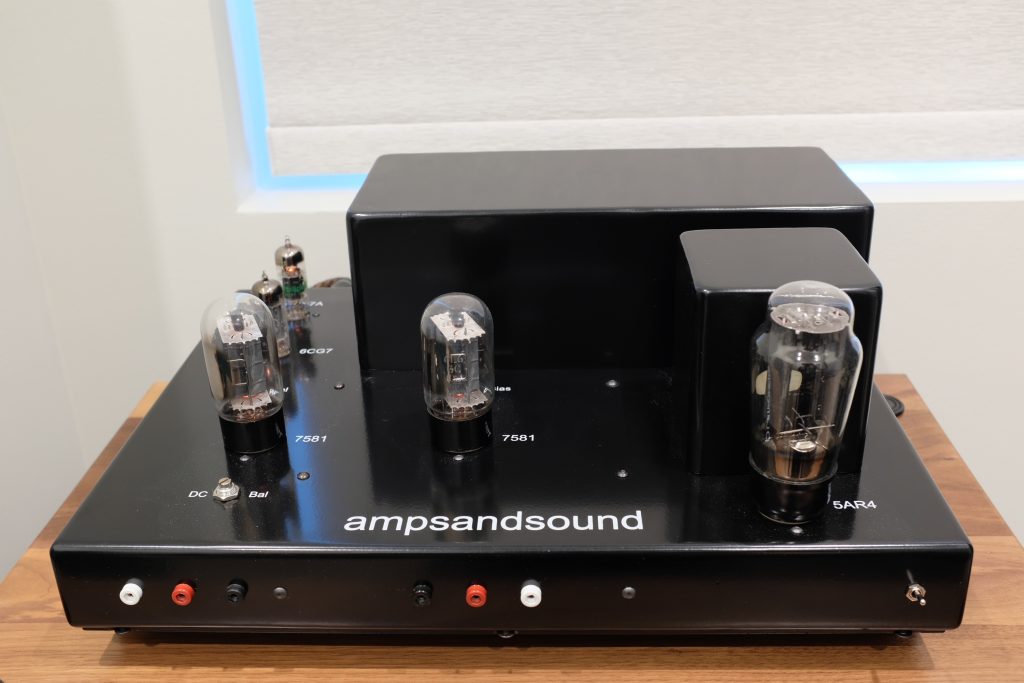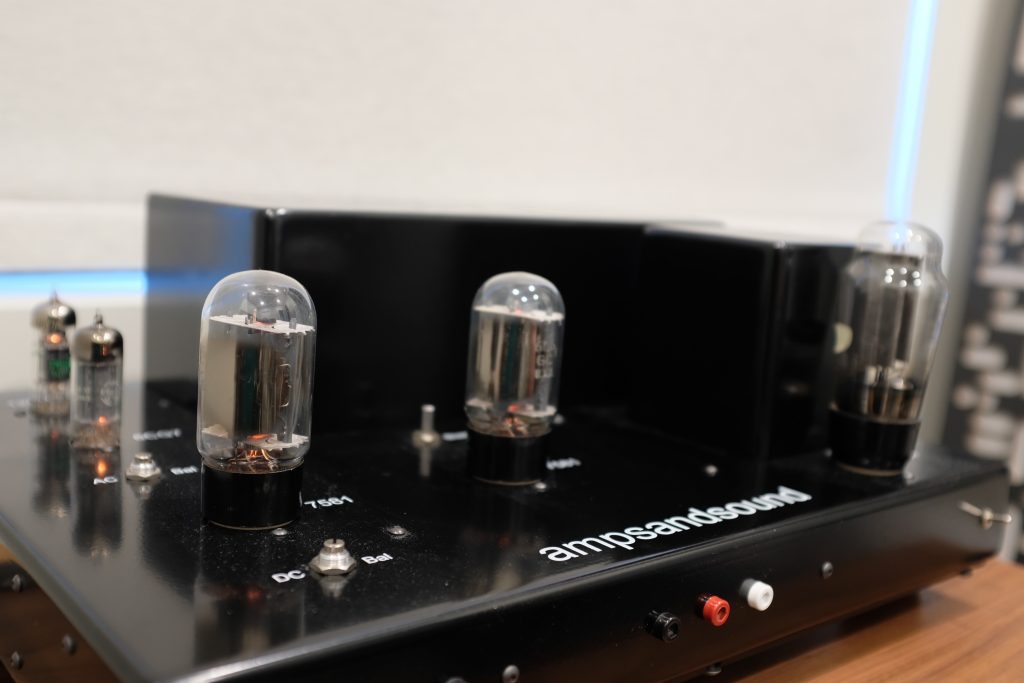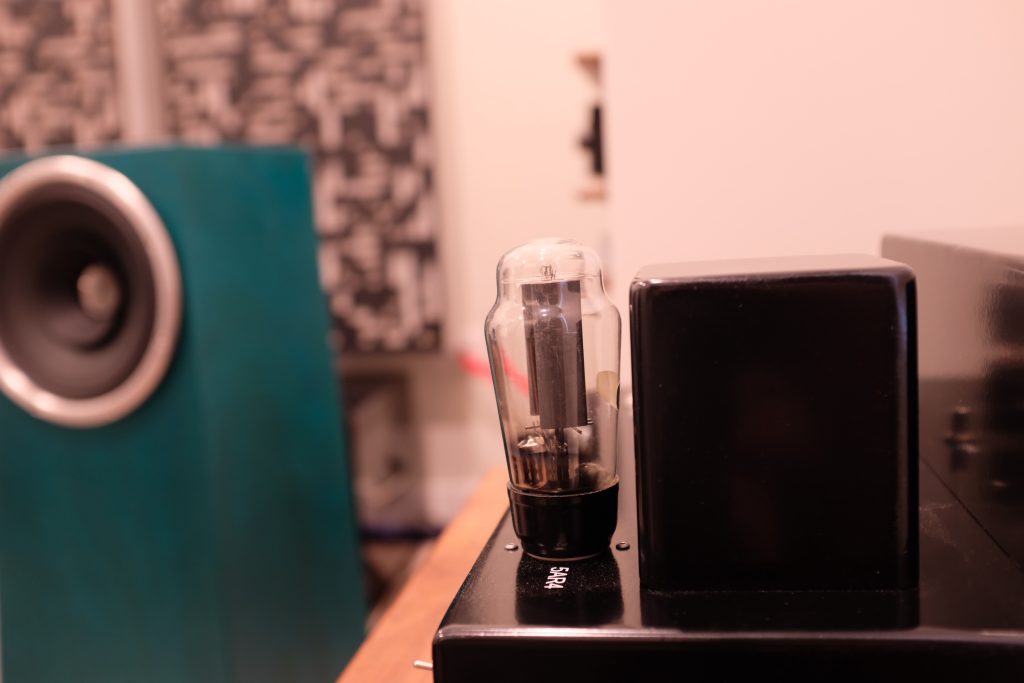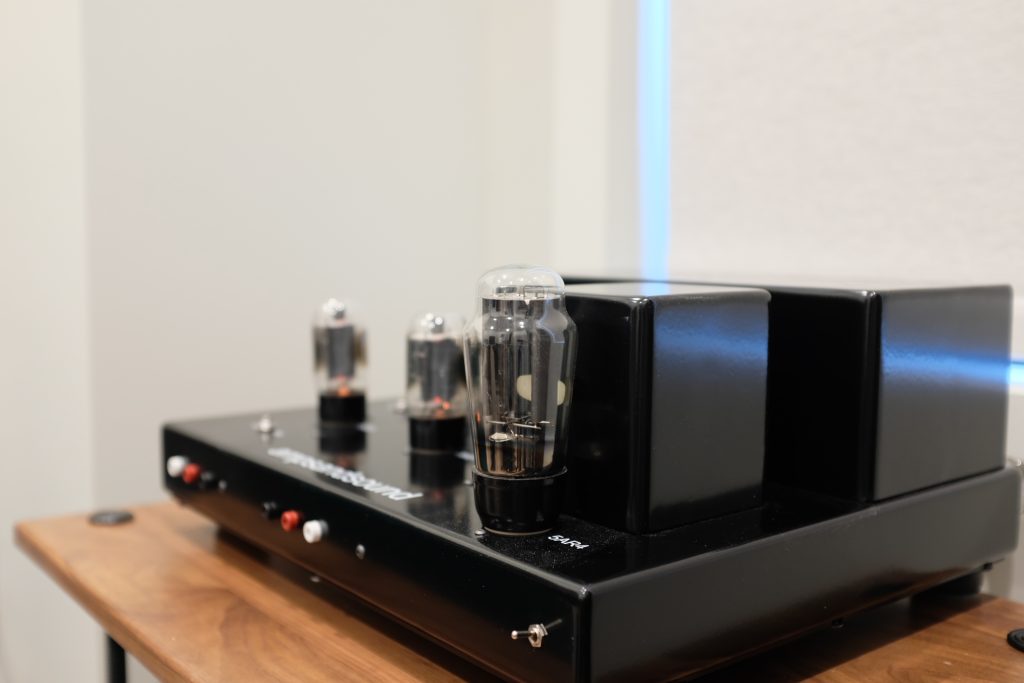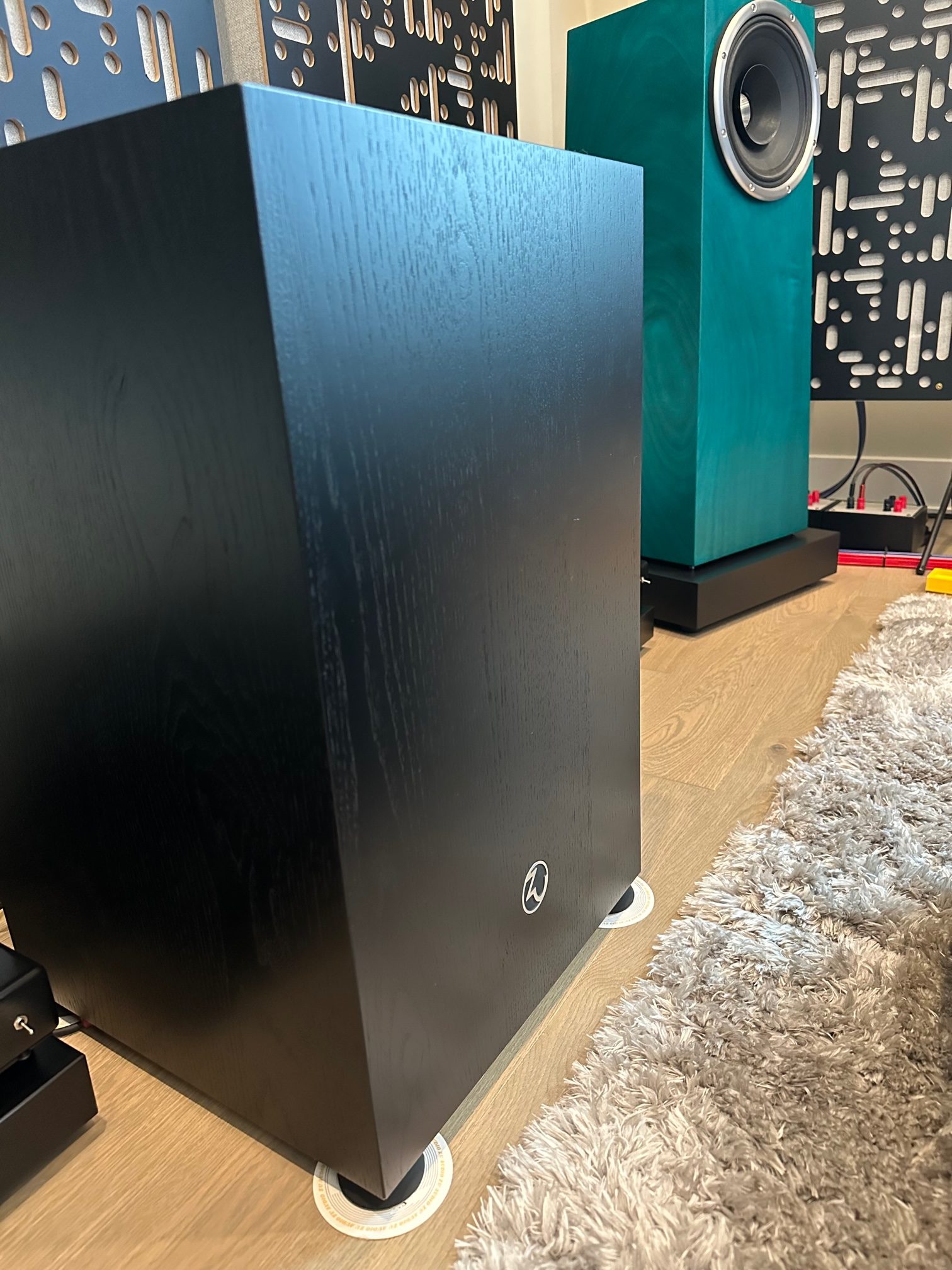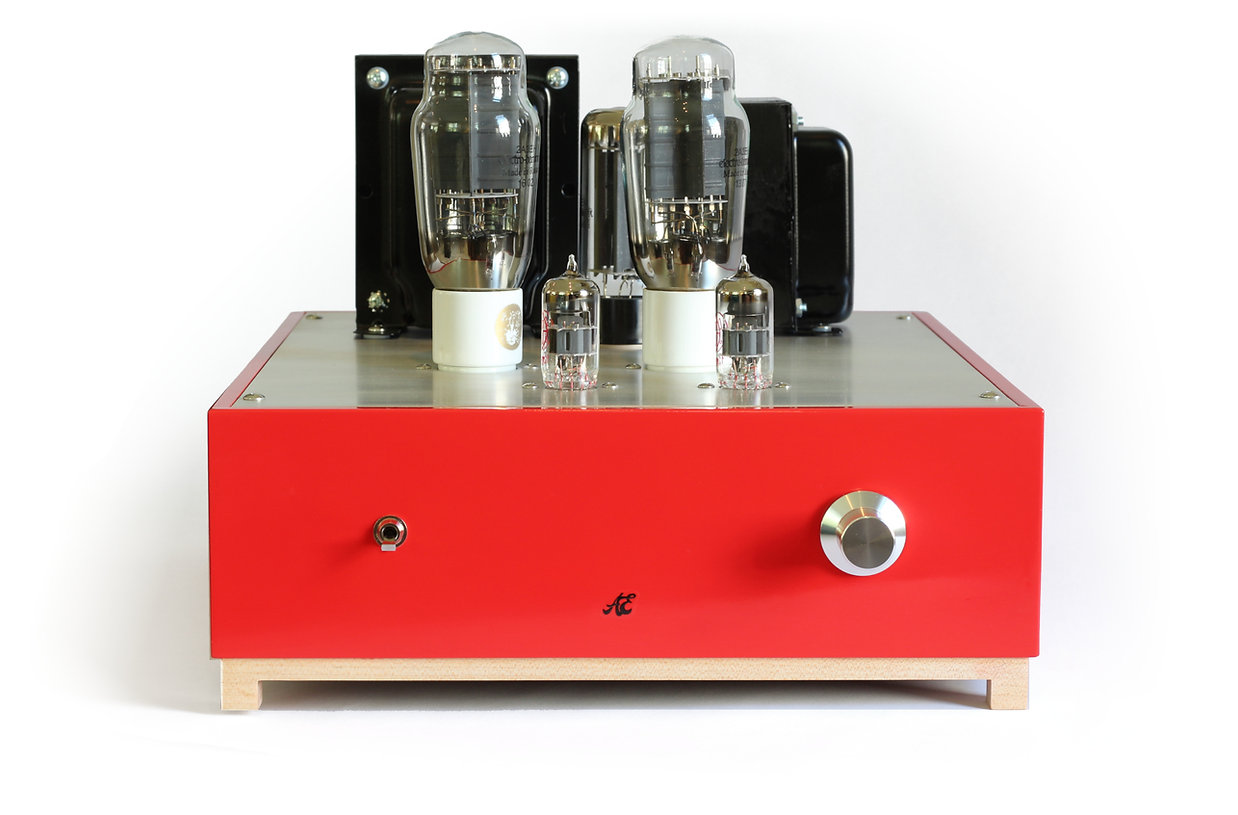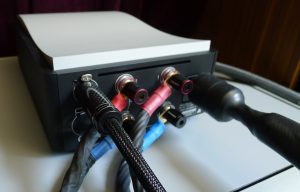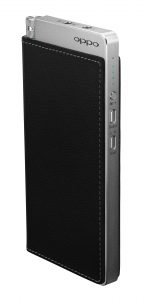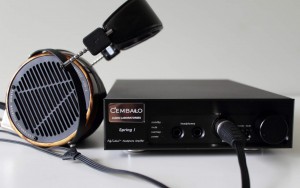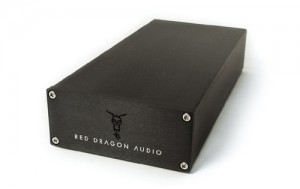Each Zion weighs nearly 75 pounds
As I sat in my listening room with the lights dimmed, I began to take a journey. My journey started with the Red Hot Chili Peppers' Unlimited Love, and I then found myself listening to Mark Knopfler's Down the Road Wherever. After awhile I ventured onto St Vincent's MasSeduction, with a short detour to MassEducation. Finally I ended the night with an incredible Pop concert, Mika's Live at Brooklyn Steel. When I was done, I pressed pause, thoroughly exhilarated from my trip and turned off the ampsandsound Zions. I then joined my wife in bed for the night.
Listening to the Zions is like taking a journey, clicking play on the next album transports you to a new venue instantaneously, and pausing returns you back to your home. Similar to the way a Porsche 911 GT3 brings you to the starting line whenever you turn it on, the Zions engage every one of your senses the minute you flip their on-off switch.
I never try to hide the fact that I love ampsandsound. Justin, ampsandsound's owner, is a friend of mine, we met when I purchased a Mogwai SE from him back in 2018. Since then I have had the pleasure of owning and listening to nearly every single amplifier he has produced, and each one is special in its own way. However, the Zions, like the Nautilus, is for headphones, is a no barred statement piece for two channel listening. When speaking with Justin, he will say that the Zions are the best amps he has ever produced, and he believes they are also the best amps money can buy. There are a small group of people, including myself, who own a pair of Zions, and each of us agree that we have not heard better (and trust me we have looked). Let's take a look at what the Zions are, and why I believe they are special.
Understanding the Zions
There are certain amplifiers that have become legends in the audio world. Two of those legends are the Harman Kardon Citation II and Citation V amplifiers. The Citation II was released in 1959 as a kit amplifier and while I could not confirm the date, the Citation V was released during the same time. The Citation II was a push-pull amplifier created for the KT88, and used 6 12BY7A pentodes (one as an input, and two as the phase splitters for each channel). The Citation V was a slightly simpler take on the Citation II, instead of KT88s it used the 7581 (6L6GC equivalent), a single 12BY7A pentode as an input tube, and a 6CG7 as the phase splitter. The originals were both solid state rectified, and their transformers were wound by the famous Manhattan transformer company. These transformers are quite the collectible, and at the time, considered some of the best vintage transformers you could buy.
Justin was always a fan of the Citation amplifiers, he believes they are some of the most technically proficient amplifiers, however, he hates the execution. If you open a Citation II or V and look inside the chassis, you would see how little room is left in the case, everything is squeezed so tightly together. One day Justin decided to take on the challenge of building his own take on the Citation V. He chose the Citation V primarily because he loves the 6L6GC, it adds just the right amount of warmth and musicality, while still being detailed and transparent. The next thing he did was split the left and right channel into their own chassis. This gave him the room to execute the circuit the same way he executes his other flagship products, with point to point wiring and turret board construction. He also changed out the solid-state rectifier and replaced it with a 5AR4 (or 5U4G) rectifier. Every element on the amplifier is over spec'd by at least 200%, including the power and output transformers, and while he and I do not recommend rolling tubes in this amplifier, you technically have the room to run KT88s or 6550s if you choose to (though personally I question why you would). Finally, the entire thing is implemented on a cold rolled steel chassis that is powder coated black. Each amplifier weighs close to 75 pounds and comes in its own flight case.
On the back of each Zion you will find two inputs; a RCA input and an XLR input. The Zions are single-ended amplifiers so the XLR input goes through a cinemag input transformer which converts the incoming balanced signal into a single-ended signal. This input transformer is the same one used on professional high end mixing boards. The input transformer allows you to get the most out of your balanced upstream equipment, and allows you take advantage of the summed noise cancellation that balanced amplifiers provide (as line noise is cancelled in the input transformer when the signals are combined in the transformer). Justin is a big fan of input transformers, while I am a bit more conflicted on them. However, I found that the Zions seemed to perform best with the input transformers, and I enjoyed what I perceived as slightly cleaner bass and a smoother more extended top end. You also have speaker binding posts for 4 ohms, 8 ohms, and 16 ohms, just like the original Citation V. These outputs are tapped directly to the transformer, just like Justin's other amplifiers. For people who own vintage Altec's or happen to own Zu Soul Supremes, the 16 ohm tap is awesome, but most will probably listen on the 8 ohm or 4 ohm tap. You will also find a fuse, a signal generator port, and a IEC power inlet. The front of the amplifier has two measurement ports per channel and the power switch.
Coming back to the Porsche 911 GT3 analogy, the Zions are more similar to a high end race car then to a fast street legal car. What I mean by this is that they require work and effort to get them running and to keep them running. There is not a single automatic or safety feature (outside of the fuse) to prevent you from driving off the road. What this means is that when operated properly, you get so close to the music that you can reach out and pull the guitar out of thin air but, getting that type of performance takes time and work. Just like it would with a high-end super car. What this means in the context of the Zions is that changing tubes is a labor of love. You have 3 variables to set, AC Balance, DC Balance, and power tube Bias. To properly adjust the first settings, you either need a total harmonic distortion analyzer or an oscilloscope, both of which also require a signal generator. The tube Bias adjustment and DC balance adjustments simply require a volt meter. For me, going through the process of setting up the Zions takes about an hour and half from start to finish, and for brand new tubes requires a bias check after 10 hours, a full checkup after 100 hours, and a third adjustment at about 500 hours. I consider this part of the fun of the amplifier, just like a person into cars would consider the maintenance part of the fun of the hobby. However, if the idea of putting this much time and energy into an amplifier sounds like a nightmare to you, the Zions simply are not for you. I promise you though, the reward you get with these amplifiers is worth every second of time you put into them.
Setting up the Zions
From left to right: 12BY7A, 6CG7, 6L6GC, 6L6GC, and a U52
As I said earlier in this review, I already own the Zions, and I have had them for nearly nine months at this point. I made no promise of a review with my purchase (which is par for the course with my ampsandsound gear), I simply think this amplifier is good enough to warrant me spending my time to write about it. When the Zions arrived, ampsandsound had already pre-setup and burned in the amplifier for me. Each tube was labeled with a number, and each tube socket had a piece of blue tape with the corresponding number marked on it. This allows a new owner to get up and running with the Zions with no effort required, just plug the tubes in, check Bias with a volt meter, and go. The shipped tube compliment was a NOS set of GE 12BY7A and 6CG7 input/phase splitter tubes and the excellent new production Tung-Sol 7581A as well as the Tung-Sol 5AR4.
Doing a quick check of the DC balance and Bias showed that the factory adjustments were dead on. Connecting the Zions to both my Soul Supremes and to my custom built horns resulted in no audible noise from six inches away, and a slight hiss with my ear in the tweeter. To be direct, the Zions are incredibly quiet. They are honest 35-watt amplifiers that can deliver transient peaks of 70-watts. At no point did I ever find a need for more power. I believe that the power specs for all of Justin's amplifiers do not translate into the real world experience, this is the most powerful sounding 35-watt amplifier I have ever heard.
I spent the first three months listening to the Zion in its stock configuration. I enjoyed the depth it offered and the nuance it revealed. With the Tung-Sol 7581As, the Zions have a very linear sound that extended low and high, it was smooth, and very quick. However, I will be the first to admit that I like things a little warmer and with a little more depth and bloom. Luckily for me I have amassed a large collection of matched quads of NOS GE 6L6GCs, and was excited to learn how to really work with these amplifiers.
To start my tube change, I brought the power tube bias all the way back to the lowest setting possible and put in the matched NOS 6L6GCs. I then set the AC and DC settings to their middle points, and turned on the amplifier and waited for it to warm up for 30 minutes.
The Zions only have a single bias setting for both power tubes. This means matched power tubes are really important. The DC balance setting allows for you to compensate for the mismatch between the two power tubes. I dialed in the power tubes at about 65% of plate dissipation using my volt meter, and then adjusted the DC balance so that the two power tubes were equaled out. This is important as DC across the output transformers can reduce bass. All that was left now was to adjust the AC balance.
The AC balance is used to set the crossover point of the two power tubes. An incorrect setting for this value will result in more distortion, specifically third harmonic distortion. In theory this setting is correct when the total harmonic distortion of the amplifier is at its lowest. Many use an oscilloscope to adjust this setting but I prefer to use a distortion analyzer as its easier to optimize for a single value then it is to use judgment on what you see in the oscilloscope screen. Luckily for me, I just so happen to have an old, but still working HP 339A distortion analyzer. What is great about the 339A is that it has a signal generator built into it. This allows me to feed a sine wave into the amplifier, and then with an 8 ohm load wired in parallel, feed the amplifier output back into the 339A for measurements. Once properly setup, I feed a 500Hz sine wave into the amplifier and adjusted the AC balance setting until I get the lowest distortion value on the 339A. Once this was complete I shut down the amplifier and moved onto the next one. After your initial setup is complete, there will likely be some Bias and DC balance drift in the next 10 hours due to the new tubes settling in. These were quick adjustments. I did a full check at 100 hours and a final check at 500 hours. This process is not hard to do, but is requires the equipment and the willingness to spend the time learning how to make the adjustments correctly. The other option of course is to bring the amplifiers to a qualified technician, but where is the fun in that?
Living with the Zions
I have spent the last six months enjoying the Zions with my full NOS tube complement. Like my DCS Rossini, it is one of those few pieces of equipment that I have had no urge or need to upgrade. No matter the speaker or the source equipment I am using, the Zions bring nuance, grace, and thunderous force. They are truly beautiful and when I think about the goals that ampsandsound had for this amplifier I think they achieved all of them. It is an update to a timeless classic that is executed at a level only found when the owner personally loves the product. The Zions are Justin's personal amplifiers, built for him, without a price point in mind. Simply, the best he could do with the tools and resources he has. Luckily for us, ampsandsound has an incredibly talented team with access to some of the best transformers and metal work in the industry. Now let's dive in and talk about how they sound.
The Review System
- Amplifier: ampsandsound Zion
- Speakers: Custom Built Horns, Zu Soul Supreme, Zu Soul 6, Anthony Gallo Ref 3.1s
- DAC: DCS Rossini used as a DAC and a Digital Pre-amplifier
- Cabling: Wireworld Eclipse interconnects and speaker cable, Wywires Platinum Power Cords
- Power Conditioning: PS Audio P12
Listening to the Zions
The Soul VI was an excellent pairing with the Zions
The thing that is truly incredibly about the Zions is the scale they are able to achieve. While this was true across all four of my speakers, I want to focus in on the Anthony Gallo 3.1s. These are relatively tough to drive; they are 4 ohm loads, but their impedance varies quite a bit throughout the frequency range. I believe they are about 88dB/watt efficient. Connecting the Zions using their 4 ohm output to the Gallos proved that at 35-watts they had more then enough power to drive the Gallos. Listening to Yello's "You Better Hide" from A Touch Yello, the entire room transported itself to the moody soundscape. Thunder and lightning cracked above your head, and the wind whistled by in an incredibly 3D experience that left me, my wife, and every guest speechless. Cranking the volume to deafening levels in my 10 x 10 listening room didn't degrade the image or the experience, it simply made it bigger. For me this is my power test, find something that images well and sounds great, then turn it up. You will notice at one point the sound stage collapses and the treble becomes harsh. This generally is your amp or your speaker telling you "I don't got this anymore, slow down." Like a race car, the Zions simply purred and said "Can we go faster?"
Power is not the most important thing when selecting an amplifier. This is something many learn when they become a true audiophile, it is not about the watts, but more so about the quality of the watts and the noise level that comes along with them. The goal then is to get the right amount of power for your setup and your space. You can go bigger, but the question becomes why? It is likely after you hit a certain point, that all you are doing is adding noise. Thirty-five watts is enough power for nearly every application (as long as its a real 35-watts).
If noise is properly controlled and the amp is well designed, the result is an explosion of detail. You of course need a set of speakers that can show that detail, and if you do then the results will speak for themselves. I am a big fan of the Red Hot Chili Peppers, but Stadium Arcadium on vinyl is a really special album. By comparison, I found their other albums to be missing dynamic range, especially in digital form (this is not just my opinion, and is widely known). However, their new Album, Unlimited Love, is an awesome listen. I personally think it is well recorded, it images quite well, and has a ton of nuanced detail. I listened to "Aquatic Mouth Dance," off of Unlimited Love on both my Soul Supremes and my Soul 6s. I am currently working on a Soul 6 review, but it is a significant step up from the Soul Supreme in every way; especially with detail retrieval. While the Supremes deliver well, the Soul 6s driven by the Zions deliver a level of detail that I simply have not experienced. I do not mean just in my own home. I mean period. When I listen to this song, I see the band, I hear the cymbals, but I also hear the rod that cymbals sit on resonate. This nuance is not there with the Soul Supremes, but exists with the Soul 6 and the Zions are transparent enough to deliver that level of detail.
No matter the piece of music, I find that the Zions deliver an enjoyable listening experience. Part of the reason for this, I believe, is the fact that the output tubes are triode strapped. Triode strapped pentodes (of which a 7581 and 6L6GC are) tend to have a warmer sound. They can be soupy, but when properly implemented they sit just to the right of neutral and breath a little bit of warmth into the music. This warmth is slight enough to never impede on a well recorded piece of music, however it makes Liz Phair's "Super Nova," off of Whip Smart an incredibly listenable and enjoyable experience. However, this same song using my 500-watt differential solid state mono-blocks makes me want to claw my ears off. I believe music should be enjoyable, and while transparency is incredibly important, if it results in the need to only listen to truly well recorded music, then maybe we have taken the concept of transparency too far. The Zions do it right, and they go all the way up to the line, without every stepping over it.
A really good amplifier is fast, and using high efficiency speakers like my horns and the Zu speakers, makes it obvious when an amplifier is struggling to keep up. A good place to look to assess speed is metal music. Metallica's "One" off of …and Justice For All is a good way to tell how fast the amplifier is capable of going, assuming you have speakers that can keep up. Luckily for me, the Soul 6 was up for the task. As we get into the last two minutes of "One," when chaos is unleashed, the Zions had no issue keeping up with every string and every drum hit, even at deafening levels. Each hit had impact, and the impact is what transformed the experience from a listening experience to a real visceral experience.
Measuring the Performance
When I spend the time to tune the Zions, as I mentioned above, I use a total harmonic distortion analyzer to set the AC balance. Specifically, I use an old HP 339A, from the 1980s. It has not been calibrated in some time, but it still seems to be reasonably accurate when measurements are compared with newer and more recently serviced THD analyzers. With all of the above in mind I wanted to share the THD measurements that I got for the Zions, as they are quite remarkable for a push pull tube amplifier. Tested at 1 volt peak to peak with a 1 kHz sine wave, each Zion measured between .0340% and .0345% THD. I cannot overstate how incredible this measurement is given the technology and the tube variance and speaks to the care that ampsandsound has taken in building and designing this amp.
Wrapping Up
In all honesty, I have never heard a bad ampsandsound product. Some of their products did not match my needs, but all were excellent, and at their price points provided a level of value rarely found in high end audio. The Zions are no exception to that rule even at their $24,000 retail price. Most people who have purchased the Zions did so because they had never heard a better amplifier. I have spoken to several of them to confirm. I count myself in the group and I am very happy about it. It has become my reference and every amplifier that comes into my listening room is now measured against the Zions. The fact that they are based on one of audio's most famous and fabled amplifiers is just icing on my listening cake.
If you want the equivalent of a 911 GT3 in your audio rack, the Zions should be on your short list. They are exceptional in every way. I wish they were easier to work with, but if that is the cost for the performance, then it's a cost I will happily pay. As I said earlier in the review, I own the Zions, I believe more people should. They have my highest recommendation.
Zion Amplifiers
Retail: $24,000
ampsandsound




